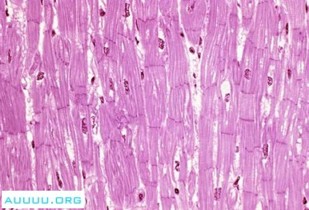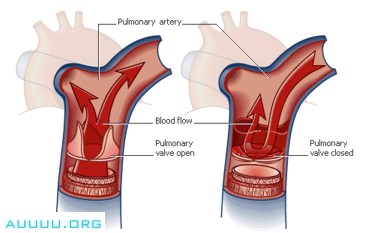|

Cardiac muscle is a unique muscle tissue found only in the heart. Unlike most forms of muscle, which are stimulated to contract by nerves or hormones, certain cardiac muscle cells can contract spontaneously. Without a constant supply of oxygen, cardiac muscle will die, and heart attacks occur from the damage caused by insufficient blood supply to cardiac muscle.
The human heart has four chambers. The upper two chambers, the right and left atria, are receiving chambers for blood. The atria are sometimes known as auricles. They collect blood that pours in from veins, blood vessels that return blood to the heart. The heart’s lower two chambers, the right and left ventricles, are the powerful pumping chambers. The ventricles propel blood into arteries, blood vessels that carry blood away from the heart.
A wall of tissue separates the right and left sides of the heart. Each side pumps blood through a different circuit of blood vessels: The right side of the heart pumps oxygen-poor blood to the lungs, while the left side of the heart pumps oxygen-rich blood to the body. Blood returning from a trip around the body has given up most of its oxygen and picked up carbon dioxide in the body’s tissues. This oxygen-poor blood feeds into two large veins, the superior vena cava and inferior vena cava, which empty into the right atrium of the heart.
The right atrium conducts blood to the right ventricle, and the right ventricle pumps blood into the pulmonary artery. The pulmonary artery carries the blood to the lungs, where it picks up a fresh supply of oxygen and eliminates carbon dioxide. The blood, now oxygen-rich, returns to the heart through the pulmonary veins, which empty into the left atrium. Blood passes from the left atrium into the left ventricle, from where it is pumped out of the heart into the aorta, the body’s largest artery. Smaller arteries that branch off the aorta distribute blood to various parts of the body.

Thin, fibrous flaps called valves lie at the opening of the heart's pulmonary artery and aorta. Valves are also present between each atrium and ventricle of the heart. Valves prevent blood from flowing backward in the heart. In this illustration of the pulmonary valve, as the heart contracts, blood pressure builds and pushes blood up against the pulmonary valve, forcing it to open. As the heart relaxes between one beat and the next, blood pressure falls. Blood flows back from the pulmonary artery, forcing the pulmonary valve to close, and preventing backflow of blood.
|